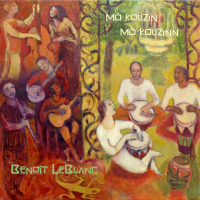Home » Jazz Articles » Megaphone » Sam Newsome: To Play or Not to Play the Soprano
Sam Newsome: To Play or Not to Play the Soprano
 When I think about the radical move I made 14 years ago, switching from the tenor to the soprano saxophone, I sometimes ask myself: "What in the hell were you thinking?" Even though in hindsight I look back on my decision with amazement and disbelief, I'm happy to say that it's one I've never regretted. Becoming a soprano saxophonist for me has been a life-changing journey that has restored my curiosity and excitement about music. It has strengthened me as a saxophonist, artist and person.
When I think about the radical move I made 14 years ago, switching from the tenor to the soprano saxophone, I sometimes ask myself: "What in the hell were you thinking?" Even though in hindsight I look back on my decision with amazement and disbelief, I'm happy to say that it's one I've never regretted. Becoming a soprano saxophonist for me has been a life-changing journey that has restored my curiosity and excitement about music. It has strengthened me as a saxophonist, artist and person. I have often equated the process of switching from the tenor to the soprano to being like "jumping off of a cliff and having to grow wings on the way down." Many of my fellow musicians thought my decision was drastic—and it was. It has been my experience that if you think about something for too long without taking action, you'll eventually talk yourself out of it—or worse, someone else will. Sometimes you have to just do it.
The soprano is probably still, today, one of the most enigmatic of all the saxophones. Since most people who play the soprano are alto and tenor players who double on the instrument, people hardly get a chance to hear the instrument's true sound potential. Mind you, there are plenty of saxophonists who double on it well, but when you hear the sound quality of someone who plays it as their primary instrument, you get to hear another layer of the instrument's sound. Sometimes it even sounds like a different instrument.
The first time I put on a Steve Lacy record, I thought to myself, "This guy's sound is peculiar." As a matter of fact, what sounded "peculiar" was the fact that it was full-bodied, focused and in tune—all of the things we demand from other horns without question. I think it was the first time that I had heard a soprano sound produced by someone who wasn't doubling on the instrument—except, of course, Sidney Bechet. When it comes to the soprano saxophone, players have convinced themselves that since the instrument is so difficult to play, having any goal other than playing it in tune seems over-ambitious. It's hard to imagine a saxophonist being happy with his or her sound on the alto or tenor saxophones just because it's in tune.
Several years ago I had an interesting conversation with Gerry Teekens, the producer and founder of Criss Cross Records, the label with which I recorded my first CD, SAM I AM. I told him that I had, for artistic reasons, decided to stop playing the tenor saxophone and wanted to make the soprano my main instrument. His response was classic. "Why would you want to do that? You sound just like Hank Mobley and Sonny Rollins." I then explained that that was exactly the reason why I wanted to switch. I was finding it increasingly difficult to find a sound on the tenor that I felt I could call my own, which for me was the most important thing. Jane Ira Bloom said it best when she said that playing the soprano, "You have the freedom of being under-influenced."
Later during that same conversation, he told me that switching to the soprano was risky because the soprano is a very limited instrument. Many people hold this opinion, but the reason people feel this way is that when they hear the soprano played, they aren't hearing the result of players having spent three to four hours a day over the course of several years devoted solely to developing a personal sound and approach on the soprano saxophone. Even though there are a handful of saxophonists who have carved out a niche on the instrument, it is still a relatively small number compared to the innovations that have been documented on other saxophones. Try to imagine what our perception of the tenor saxophone would be like without the diversity of approaches from Lester Young, Coleman Hawkins and Sonny Rollins to John Coltrane, Stan Getz and Albert Ayler.
In the beginning stages of playing the soprano exclusively, I, too, felt some of the limitations of the instrument. The most noticeable was not having that deep lower register that one takes for granted when playing the alto, tenor and baritone saxophones. But over time I have discovered that this can be overcome by developing other areas of the instrument. The three techniques that I have found to be the most effective in achieving this are through the use of the altissimo register, the use of multiphonics and the use of quarter-tone fingerings. Having developed my altissimo on the soprano, I now have a four-octave range, which in some ways enables me to approach the instrument like a flute. Having developed my cross-fingering technique (another name for alternate fingerings), I'm now able effectively to incorporate multiphonics and quarter-tones into my music. Multiphonics are great because you can harmonize your own notes, giving them more weight and presence. Mastering quarter-tone fingerings gives you not only twice as many notes to work with within an octave, but enables you to play non-Western scales and melodies. Mind you, these things are easier said than done. Examples of these techniques can be heard on my solo CDs: Monk Abstractions (s/r, 2006) and the soon-to-be released Blue Soliloquy: Microtonal Explorations of the Blues.
Will the soprano ever be viewed with the same reverence as other instruments? I guess only time will tell. Steve Lacy said that there was a time when the only two modern jazz soprano saxophonists were John Coltrane and himself. Today, that is no longer the case. People often forget that the first jazz saxophone soloist was soprano saxophonist Sidney Bechet, who rivaled Louis Armstrong for the title "King of Jazz."
I feel very optimistic about the future. I do foresee a day when junior high and high school band students will have the option to play the soprano, rather than just being limited to the alto, tenor and baritone saxophones. As instrument makers continue to improve the instrument, composers and musicians continue to write and perform music written for the instrument. I see a new day, when the soprano will be on top, not just in register, but also in reverence!
Tags
PREVIOUS / NEXT
Support All About Jazz
 All About Jazz has been a pillar of jazz since 1995, championing it as an art form and, more importantly, supporting the musicians who make it. Our enduring commitment has made "AAJ" one of the most culturally important websites of its kind, read by hundreds of thousands of fans, musicians and industry figures every month.
All About Jazz has been a pillar of jazz since 1995, championing it as an art form and, more importantly, supporting the musicians who make it. Our enduring commitment has made "AAJ" one of the most culturally important websites of its kind, read by hundreds of thousands of fans, musicians and industry figures every month.

























